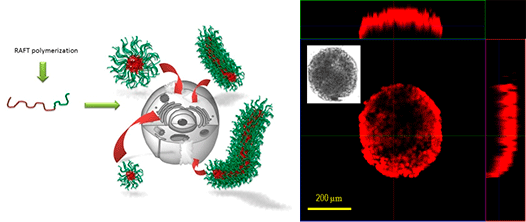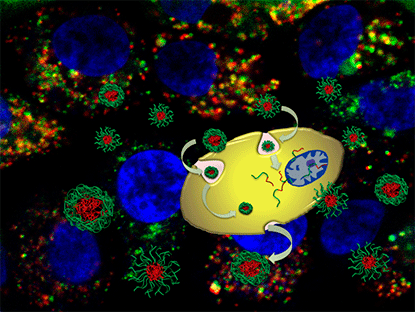Polymers for Health 1
Self-assembled block copolymers and their interaction with mammalian cells in 2D and 3D
Investigator:
Prof Martina Stenzel
Collaborators:
Dr Megan Lord (Graduate School of Biomedical Engineering)
Dr Mohammad Pourgholami (St. George Hospital)
Dr David Morris (St. George Hospital)
Funding: ARC DP
RAFT (reversible addition fragmentation chain transfer) polymerization is an excellent tool to create block copolymers. Over the years, we have generated hundreds of different polymer architectures using RAFT polymerization. Attractive is in particular the robustness of the process in the presence of many functional groups, but also the possibility to adjust the length and nature of each block. Initially, the work was focused on the synthesis of block copolymer using the RAFT process. Understanding the underpinning mechanism of the RAFT process could determine the success of the block copolymer synthesis. Our main focus is to generate amphiphilic block copolymer, which can self-assemble into micelles, but also cylindrical micelles and vesicles.
These self-assembled aggregated as proposed as drug carriers due to their hydrophobic interior, while size and shape can easily be influence by the underlying polymer.
These years of experience in the synthesis of block copolymer by RAFT polymerization allowed us to tailor block copolymers depending on the application. The nature of the block copolymer was adjusted to solve a range of drug delivery problems. This includes traditional anti-cancer drugs, but also other, more challenging bioactive molecules such as DNA and heparin. The central questions are how we can design a suitable polymer to encapsulate the drug and how does the polymer affect the properties of the nanoparticle?

Figure. Left: Control of the aggregate size and shape by changing the block length of the block copolymer; Right: Micelles penetrating into a spheroid cancer model
On the quest for suitable drug delivery carriers for various drugs we developed a synthetic tool kid to achieve the possible best cellular uptake. We are interested in stabilizing the micelles by crosslinking, which often leads to a better cell uptake. In addition, replacing the more tradition PEG shell of micelles by other polymers such as zwitterionic structure, we could create drug carriers that are not only non-toxic, but also show a very high uptake efficiency. This would not have been possible without the use of modern synthetic tools such as RAFT polymerization and click chemistry and we are always on the look-out for new innovative developments in the area of polymer synthesis.

Figure. Schematic presentation of endocytosis and exocytosis of uncrosslinked and crosslinked micelles
References
- Gregory, A.; Stenzel, M. H., Complex polymer architectures via RAFT polymerization: From fundamental process to extending the scope using click chemistry and nature's building blocks. Progr. Polym. Sci. 2012, 37 (1), 38-105.
- Stenzel, M. H., RAFT polymerization: an avenue to functional polymeric micelles for drug delivery. Chem. Commun. 2008, (30), 3486-3503.
- Kim, Y.; Binauld, S.; Stenzel, M. H., Zwitterionic Guanidine-Based Oligomers Mimicking Cell-Penetrating Peptides as a Nontoxic Alternative to Cationic Polymers to Enhance the Cellular Uptake of Micelles. Biomacromolecules 2012, 13 (10), 3418-3426.
- Kim, Y.; Pourgholami, M. H.; Morris, D. L.; Stenzel, M. H., Effect of Cross-Linking on the Performance of Micelles As Drug Delivery Carriers: A Cell Uptake Study. Biomacromolecules 2012, 13 (3), 814-825.
- Kim, Y.; Pourgholami, M. H.; Morris, D. L.; Lu, H.; Stenzel, M. H., Effect of shell-crosslinking of micelles on endocytosis and exocytosis: acceleration of exocytosis by crosslinking. Biomaterials Science 2013, 1 (3), 265-275.
